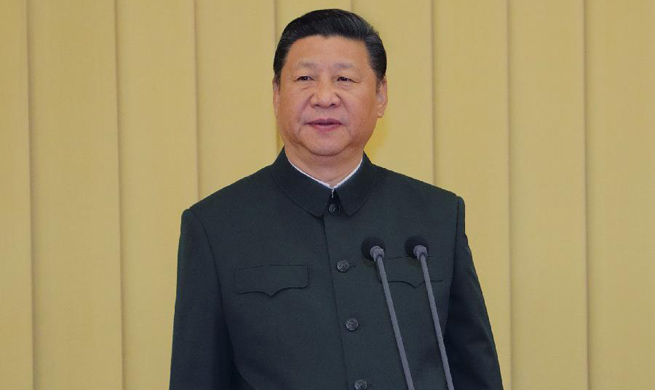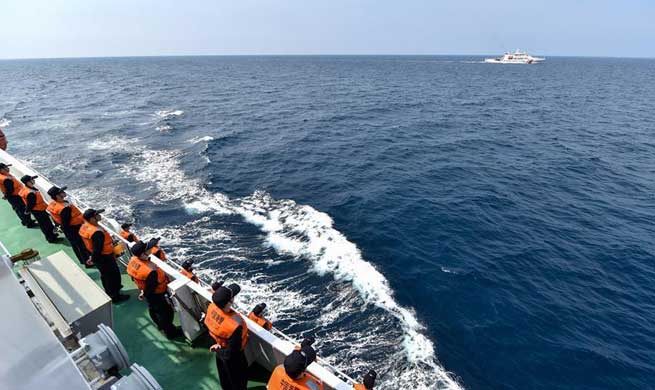BEIJING, April 19 (Xinhua) -- China's first cargo spacecraft Tianzhou-1 is scheduled for launch at 7:41 p.m. Thursday from the Wenchang Space Launch Center in south China's Hainan Province, the office of China's manned space program said Wednesday.
The cargo spacecraft will be carried into orbit by a Long March-7 Y2 carrier rocket, the office said.
Tianzhou-1 is the first cargo ship independently developed by the country. It is expected to operate in orbit at an altitude of 380 kilometers before docking with the orbiting Tiangong-2 space lab.
The cargo spacecraft will also carry out space experiments, including one on non-Newtonian gravitation, before falling back to earth.
Following are major facts about China's manned space program:
Shenzhou-1
Launched: 6:30 a.m., Nov. 20, 1999
Landed: 3:41 a.m., Nov. 21, 1999
The main task was to examine the performance and reliability of the launcher and verify key technology relating to the capsule connection and separation, heat prevention, control and landing.
Shenzhou-2
Launched: 1:00:03 a.m., Jan. 10, 2001
Landed: 7:22 p.m., Jan. 16, 2001
Shenzhou-2 was the first formal unmanned spacecraft. The launch was conducted in conditions usually required for a manned spacecraft. It carried out several experiments in various fields of space, including life science, materials, astronomy and physics under conditions of microgravity.
Shenzhou-3
Launched: 10:15 p.m., March 25, 2002
Landed: 4:51 a.m., April 1, 2002
The module carried human physical monitoring sensors and "dummy astronauts." It was also equipped with escape and emergency rescue functions.
Shenzhou-4
Launched: 12:40 a.m., Dec. 30, 2002
Landed: 7:16 p.m., Jan. 5, 2003
The module was launched at a temperature of minus 29 degrees Celsius. Excessive harmful gas, found in the previous three crafts, was reduced to a safe level in the fourth module. Radiation-proof facilities and automatic and manual emergency rescue systems were installed on the spacecraft.
Shenzhou-5
Launched: 9 a.m., Oct. 15, 2003
Landed: 6:23 a.m., Oct. 16, 2003
The launch of the spacecraft was the first manned mission, which realized the nation's thousand-year dream of manned space flight and was a new milestone in China's space program.
The craft carried astronaut Yang Liwei.
Shenzhou-6
Launched: 9:00 a.m., Oct. 12, 2005
Landed: 4:33 a.m., Oct. 17, 2005
China's second manned spaceflight carried astronauts Fei Junlong and Nie Haisheng.
The mission aimed to master technology relating to a "multi-person and multi-day" orbital flight, as well as to carry out manned space-related scientific experiments and medical experiments.
Shenzhou-7
Launched: 9:10 p.m., Sept. 25, 2008
Landed: 5:37 p.m., Sept. 28, 2008
China carried out a historic first spacewalk by a Chinese astronaut. Zhai Zhigang, Liu Boming and Jing Haipeng were onboard.
Zhai left the cabin at 4:34 p.m. Sept. 27, about 43 hours after the craft launched, remaining outside the craft for 19 minutes and 35 seconds. China became the third country in the world to conduct extravehicular activity in space, following the Soviet Union and the United States.
Shenzhou-8
Launched: 5:58 a.m, Nov. 1, 2011
Docked with Tiangong-1 space module: 1:36 a.m., Nov. 3, 2011
Landed: 7:30 p.m., Nov. 17, 2011.
The return of the unmanned spacecraft Shenzhou-8 marked the end of the 49-day space docking mission, and it was hoped that it would pave the way for the establishing of China's own space station.
China not only made a breakthrough in space docking technology, but also validated the capability of its rocket, spacecraft and entire system, laying solid foundations for the building of a space station.
Shenzhou-9
Launched: 6:37 p.m, June 16, 2012
Docked with Tiangong-1 space module: around 2 p.m., June 18, 2012
Landed: 10:03 a.m., June 29, 2012
The return of the Shenzhou-9 spacecraft to Earth marked the end of a 13-day journey through space for three Chinese astronauts who completed China's first manned space docking.
The craft carried the first Chinese female astronaut Liu Yang.
It also marked the beginning of a new journey for China as it inched closer to its goal of building a space station.
Shenzhou-10
Launched: 5:38 p.m., June 11, 2013
Docked with Tiangong-1 space module: 1:18 p.m., June 13, 2013
Landed: 8:07 a.m., June 26, 2013
Shenzhou-10 was China's first application-oriented space flight. In its 15-day journey in space, Shenzhou-10 docked with the orbiting space lab Tiangong-1 twice, once through automatic operation and once manually.
The astronauts spent 12 days in Tiangong-1, where they conducted medical experiments, technical tests and delivered a lecture to students on Earth about basic physics principles.
Compared with the previous mission Shenzhou-9, Shenzhou-10 was not experimental but an applicable shuttle system for transporting astronauts and supplies to orbiting modules.
Shenzhou-11
Launched: 7:30 a.m., Oct. 17, 2016
Landed:1:59 p.m., Nov. 18, 2016
After its launch on Oct. 17, the spacecraft docked two days later with China's first space lab, Tiangong-2, where the two astronauts lived for 30 days.
The mission aimed to transport personnel and materials between Earth and the space lab Tiangong-2, as well as test meeting, docking and return processes. It fulfilled the longest manned mission in the country's space program to date.
The module marked the imminent end of the exploratory stage of China's manned space program, which will carry out manned space missions on a regular basis with the establishment of its own space station.
Tiangong-1
Launched: 9:16 p.m., Sept. 29, 2011
The orbiting Tiangong-1 space module docked with Shenzhou-8, Shenzhou-9 and Shenzhou-10 spacecraft and undertook a series of experiments.
Tiangong-2
Launched: 10:04 p.m., Sept. 15, 2016
Designed to enable two astronauts to live in space for up to 30 days and to receive manned and cargo spaceships, Tiangong-2's interior living quarters and life support system have been improved to allow longer astronaut stays, compared to its predecessor.
The module marked another milestone in the country's increasingly ambitious space program, which envisions a mission to Mars and its own space station.

















